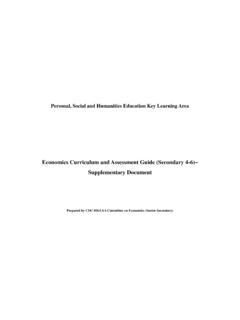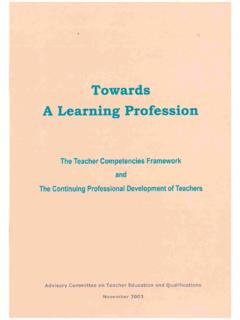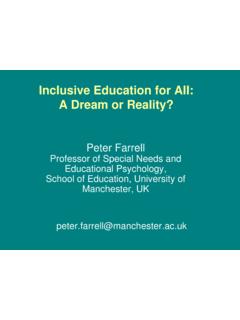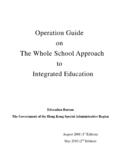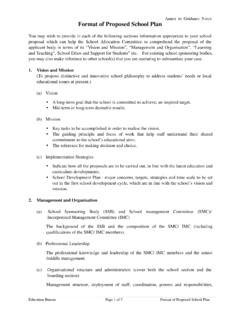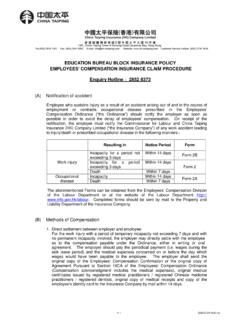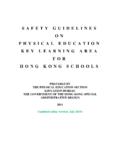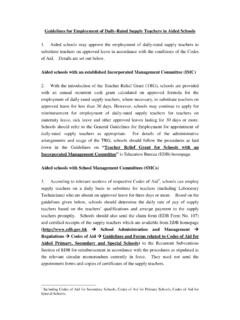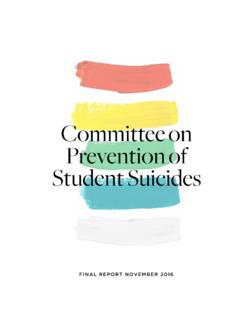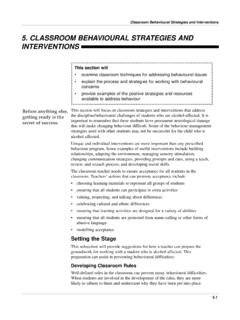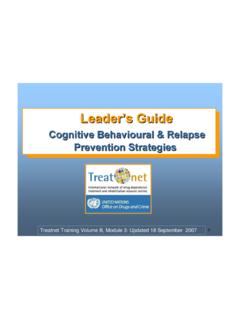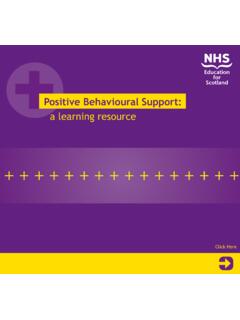Transcription of Chapter 5 Basic Behaviour Theory and Techniques
1 Basic Behaviour Theoryand TechniquesChapter 5 Basic Behaviour Theory Ways to Analyse BehaviourHow to Modify Children s BehaviourEstablishing Good RelationshipsCommon Pitfalls in Applying behavioural Techniques5 Basic Behaviour Theoryand Techniques50 Chapter 5: Basic Behaviour Theory and Techniques When teachers have children with special needs in class, early identification of their problems and arrangement for referral is only the first step. Teachers also need to manage the children's learning, emotional and behavioural problems in the classroom in order to help them adapt to school life and learn more easily. To handle these issues effectively, teachers must understand the Basic behavioural principles and Techniques .
2 This Chapter will introduce the Basic Behaviour Theory , ways to analyse Behaviour , and how to modify children's human Behaviour is complex and varies greatly among individuals, certain behavioural patterns can be identified. Put it simply, when our Behaviour (whether desirable or undesirable) is followed by a positive and encouraging response (such as praise or reward), the chance of us repeating this Behaviour will increase. However, if our Behaviour is followed by a negative response (such as criticism or reproach ), or even no response, the chance of us repeating this Behaviour in the future will be example, when a boy takes the initiative to answer a question, regardless of whether he is right or wrong, the teacher responds positively by praising his active attempt, the chance of the boy answering questions actively again will increase.
3 On the other hand, if the teacher shows disapproval publicly towards the boy s incorrect answer, the chance of the boy answering questions actively in the future will be Basic Behaviour Theory The Basic behavioural principle: Law of EffectPositive / encouraging response or consequenceBehaviourBehaviourBehaviourBe haviourNegative response or consequence5 Basic Behaviour Theoryand Techniques51II. Ways to Analyse BehaviourRefer to Chapter 5 of the DVD1. Understanding the Motivation and Functions behind Behaviour2. Analysing the Antecedents and Consequences of a BehaviourTo get things they like, praise, attention, material reward and interesting activities; orTo avoid things they dislike, reproach, neglect, punishment and activities they did it usually happen?
4 Where did it usually happen?Who were there?What happened?What did the others say / do?What did the child say / do?What happened?What did the others say/do?What could the child get from it?What could the child avoid?The motivation behind children s Behaviour is relatively simple. It is mainly:Being able to understand the motives behind children s Behaviour helps teachers decide on the methods used to modify their Behaviour . It will also allow teachers to predict which methods will be more effective and which will be are usually antecedents and consequences to a Behaviour . An antecedent refers to the event happened immediately before the occurrence of a Behaviour . It (could be a person, a setting or an incident) may be the factor triggering the Behaviour .
5 A consequence refers to the event appears right after the occurrence of a Behaviour , , the child gets a reward or loses certain and consequence are often crucial factors influencing whether a Behaviour will occur. If we can fully understand the antecedent and consequence of a Behaviour , we will have the essential clues to change the Behaviour . This method of analysing Behaviour is termed ABC Behaviour Analysis.(Teachers may refer to Appendix 4: ABC Behaviour Record to record and analyse a child s Behaviour .)AntecedentConsequenceBehaviou r5 Basic Behaviour Theoryand Techniques52 III. How to Modify Children s BehaviourRefer to Chapter 5 of the DVDFor example, when the teacher asks a question, a child always tries to answer the question without raising his hand.
6 The teacher tries to ignore him, but the child shouts and yells. In order not to disrupt the class, the teacher has to let him answer. Let us try to analyse the antecedent and consequence of this problem Behaviour :In this example, we find that whenever the teacher ignores the child , the child tends to shout and yell to get the teacher s attention. In addition, the teacher eventually lets the child answer the question in order not to disrupt the class , which further reinforces the child s problem Behaviour of shouting and yelling. Therefore, to tackle this problem, the teacher may try to:The methods mentioned below can effectively modify children s Behaviour . When dealing with children s behavioural problems, we tend to focus on how to reduce undesirable Behaviour and neglect how to encourage desirable Behaviour .
7 In fact, both are equally important. When children behave well more often there will be less time and opportunity for them to misbehave. Therefore, teachers should try to use the methods complementarily and flexibly when they refer to the strategies described child did not raise his hand to answer questions and the teacher ignores child shouts and yells in teacher lets him answer in order not to disrupt the the antecedent: Set the rule of raising hand before answering questions in the consequence: If the child shouts and yells, do not let him answer the question. Instead, use the management strategies in the next section to reduce the child s undesirable the child abides by the rule and raises his hand before answering the question, praise and encourage him accordingly to reinforce the child s desirable Behaviour Theoryand Techniques53 Don t shout Don t run Don t snatch other's toys Keep quiet or Speak softly Walk slowly Share toys with others 1.
8 Setting Rules2. Giving prompts/instructionsWays to Change AntecedentsAs mentioned above, antecedents refer to events occurred right before a Behaviour . For example, is the child more likely to display such Behaviour in certain classes (when did it usually happen)? Knowing the clues about antecedents allows us to apply the following methods to change the antecedent such that problem Behaviour can be children to have desirable Behaviour , we should better set up rules in advance. The rules must be:In addition, teachers should also:After the rules have been established, prompts/instructions should be used as reminders when children do not follow them right away. When giving prompts/instructions:Negative statementPositive statementChanged toAppropriate in number - A maximum of 3 to 4 will be enough.
9 Children will forget if there are too many and easy to follow - They should match with the children s age and development, and the children should be able to carry them out. Able to be implemented practically - Pay attention to any limitations of the objective positive terms - Instructing children not to do certain things can only stop the undesirable Behaviour without teaching them the acceptable Behaviour . If children have not learned what they should do, soon they will do the undesirable Behaviour again. Therefore, when setting rules, negative statements should be turned into positive ones. For example:Be fair. All children in class must follow the setting the rules, all the teachers should enforce them concisely, such as, Raise your hand before answering.
10 Avoid long not ask children questions such as Is it or Would as it will give children the chance to say no .5 Basic Behaviour Theoryand Techniques543. Offering Limited Choices4. Diverting AttentionChildren are generally more obedient and cooperative when offered the right to children limited choices can avoid them going into tantrums for insisting on getting what they example, let children pick a snack from a choice of three, or an activity from a choice of soon as you notice a child is going to misbehave, try diverting his/her attention and lead him/her to engage in another method is particularly suitable for younger example, if two children are going to fight over a toy, the teacher can take out two other interesting toys to distract them.
